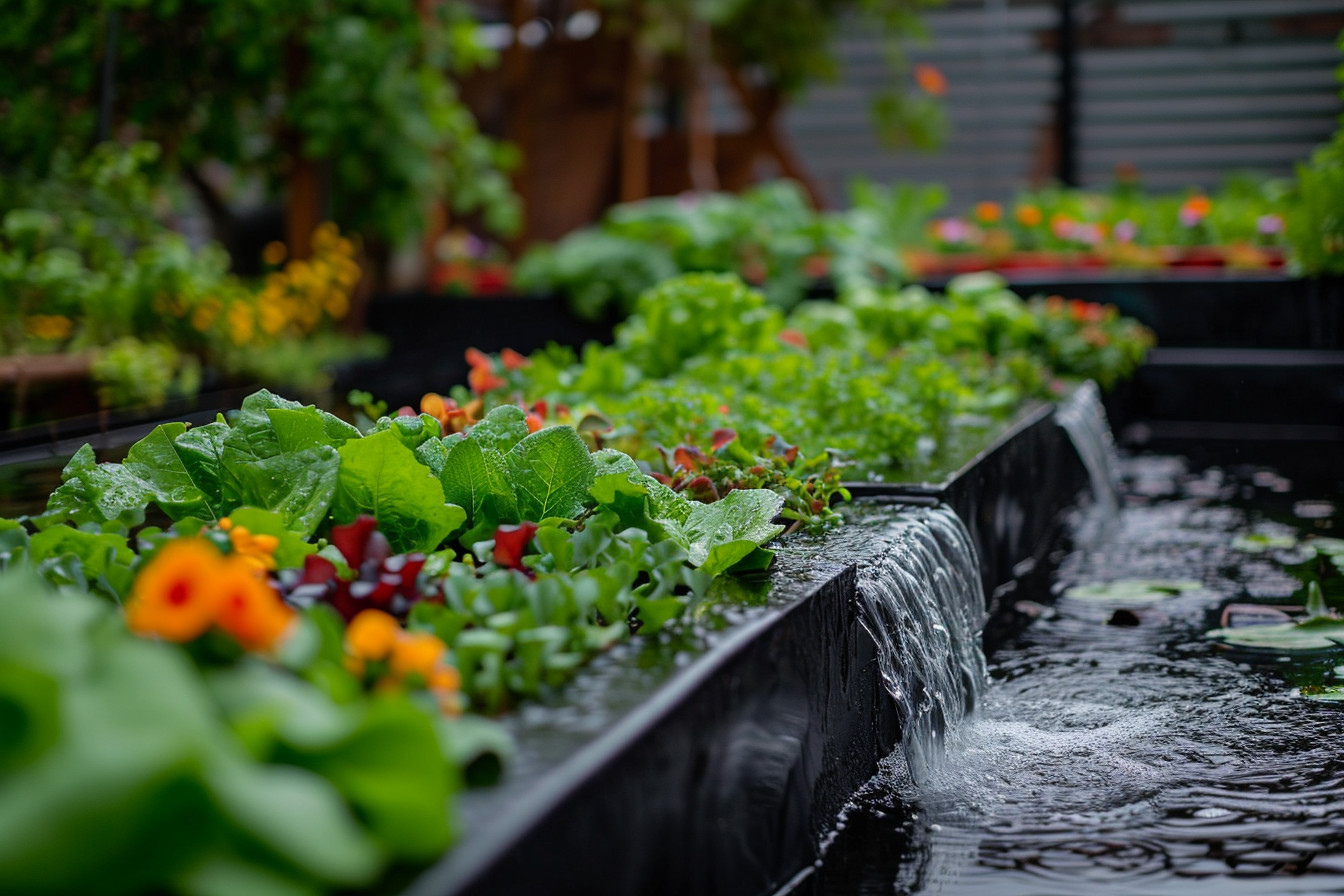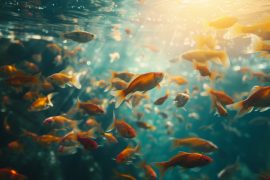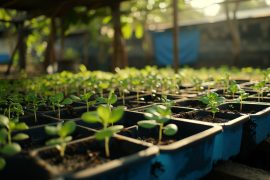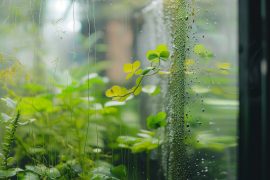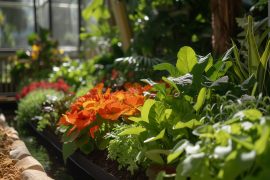Imagine stepping into a serene garden where water gurgles softly and plants thrive, suspended in a dance with fish that glide below. That’s the peaceful world of aquaponics, a place where the hustle of daily life gives way to a tranquil symphony of nature.
I’m here to unravel the science behind aquaponics in a way that’s as easy to digest as fresh salad from your garden. Think of it as a blend of aquaculture and hydroponics, where fish and plants grow together in a harmonious cycle. It’s a bit like having your cake and eating it too, except with fish and veggies—and who doesn’t love that?
So let’s dive into the basics, where I’ll break down the technical jargon into simple concepts. By the end, you’ll see how this elegant system can turn gardening into not just a hobby, but a story of balance and sustainability.
What is Aquaponics?
I’ve always been fascinated by the way nature works in harmony, and that’s exactly what aquaponics showcases. Picture a tranquil garden, and imagine combining it with a peaceful aquarium. That’s aquaponics for you – a slice of serene cooperation between fish and flora.
Aquaponics is a system that unites fish and plants in a single environment. It’s the marriage of aquaculture (raising fish) and hydroponics (growing plants without soil), where the fish waste provides an organic nutrient source for the plants, and the plants, in turn, purify the water.
It’s a symbiotic relationship; the fish are happy doing their thing, while the plants thrive on the nutrients, and there’s a bonus – this whole cycle reduces the need for chemical fertilizers, which is a big thumbs up for the environment.
Here’s how this fascinating system works. The waste produced by fish contains ammonia, which isn’t great for the fish if it builds up too much, but it’s perfect for the plants. Through the help of a biological filter, friendly bacteria convert this ammonia into nitrates, which are like candy for plants. These nitrates then act as a fertilizer, and the plants absorb them eagerly, cleaning the water in the process. This filtered water cycles back to the fish, and voila, the circle of life continues.
This technique isn’t just modern wizardry; it ties back to ancient practices from various cultures that understood the value of integrated farming. They knew that when you pair different living organisms together, they could help each other flourish. I’m just here to break it down and showcase how you, too, can make it a part of your modern life.
You might be thinking this sounds complicated, but here’s the kicker – it’s not. The science behind aquaponics is pretty straightforward once you get the hang of it, and it’s quite accessible. I’ve seen schools, backyards, and community gardens all embrace aquaponics, each adapting it to their own space and scale.
The Aquaponics Cycle
When I think about the serenity of my aquaponics garden, it’s not just the peaceful flow of water or the lush greenery that calms me. It’s the awareness of the intricate cycle happening right before my eyes. Picture this: it starts with the fish, swimming contentedly in their tank. They’re not just pets; they’re a pivotal part of a system that’s as ancient as it is ingenious.
Fish produce waste—no news there. But in an aquaponics system, that waste doesn’t go to waste. Instead, it’s converted into something precious: nutrients for my plants. Here’s where the science gets interesting, and don’t worry, I’ll keep it simple. There are beneficial bacteria that live in the growing medium—let’s call them nature’s little helpers. These microbes work tirelessly to break down the fish waste, turning ammonia, which isn’t great for fish if it builds up, into nitrates. Nitrates are like gold for plants—they’re one of the key nutrients that help my green buddies thrive.
As the water, enriched with these nitrates, flows into the plant beds, something wonderful happens. The plants dip their roots into this nutrient-rich water and drink up everything they need to grow. In return, they do a fantastic favor for the fish: they clean the water. Yep, by the time the water filters through the plant roots and the growing media, it’s been scrubbed clean of impurities and can flow back into the fish tank. This creates a closed-loop system, a continuous cycle of life, if you will.
This is the heart of an aquaponics garden—a beautiful, sustainable relationship where fish and plants support each other. But it’s not just them; there’s this whole community of organisms, from the bacteria to the occasional visiting frog, each playing a part in the garden’s ecosystem.
To give you a real-world picture, let’s talk about a school I visited once. They had set up a small aquaponics system in the classroom. Those kids saw firsthand the beauty of this cycle. They fed the fish, monitored the water, and watched the plants grow. The excitement on their faces when they harvested their first lettuce—it was priceless. And it all clicked, the entire process, from fish waste to salad plate.
How Does Aquaponics Work?
As I delve deeper into the peaceful world of aquaponics, it feels like I’m not just growing plants and fish; I’m cultivating harmony. It’s a dance of balance and patience, where every component works in unison. Now, let’s break down how this serene system operates.
Visualize a tank full of fish, just swimming about. These fish are more than just potential pets or future meals; they’re a crucial part of a larger ecosystem. Here’s the fascinating bit: the waste they produce doesn’t go to waste. It contains ammonia, which might sound harmful, and in large quantities, it can be. But here’s where the magic happens—beneficial bacteria, nature’s tireless recyclers, convert this ammonia into nitrates, which are like a superfood for plants.
Above the fish tank, there’s typically a bed of plants, basking in light and looking quite content. They’ve got their roots dipped in the water derived from below, and they’re sipping on those nitrates like it’s the finest nutrient-rich cocktail tailored just for them. As they soak up these nutrients, the plants are essentially purifying the water, which can then be cycled back to the fish. It’s nature’s barter system at its most efficient.
In my own aquaponic journey, I remember setting up a small system in my backyard. It started with just a few leafy greens and some hardy tilapia. I found this balance between feeding the fish and harvesting the plants oddly meditative. And over time, I saw this miniature ecosystem flourish, which was immensely satisfying.
Thinking about the technical side, it’s important to keep things accessible. One term that threw me for a loop when I started was “nitrogen cycle”, but it’s not as complicated as it sounds. It’s simply the process fish waste goes through to become plant food—first ammonia, then nitrites, and finally nitrates. Without this cycle, the system would collapse. But when it’s up and running, it’s a testament to the efficiency of nature.
The Role of Fish in Aquaponics
When I first delved into the serene world of aquaponics, I was drawn in by the gentle flow of water and the flickering movement of fish in their aquatic homes. It didn’t take me long to discover that in this tranquil underwater ballet, the fish play a pivotal role beyond their decorative appeal.
As I watched my own fish glide through the water, I realized they were more than just a soothing presence. They were hard at work. The waste they produce, which might seem like a problem in a regular fish tank, is actually the lifeblood of an aquaponics system. As the fish continue their dance, they release ammonia into the water – a byproduct of their digestion process.
It’s in this moment the magic begins. Beneficial bacteria, which find a home in the nooks and crannies of the grow media, get to work transforming this ammonia. Ammonia, although toxic to fish at high levels, is converted into nitrites and then nitrates, which are like gold for plant growth. This process, appropriately named the nitrogen cycle, is a testament to nature’s ingenuity.
To give you a clearer picture, here are some key stats from my own aquaponics setup:
| Fish Waste Component | Conversion Process | Resulting Plant Nutrient |
|---|---|---|
| Ammonia (NH3) | Bacterial action | Nitrite (NO2−) |
| Nitrite (NO2−) | Bacterial action | Nitrate (NO3−) |
Every day, I’m reminded of the importance of balance in this system as I feed my fish and monitor their health. The quantity and quality of the food I provide has a direct impact on plant growth rates. Overfeed the fish and the system can become unbalanced, underfeed them and plant growth could suffer.
In the larger narrative of aquaponics, each fish is a character contributing to the overall tale of self-sustainability. Schools that incorporate aquaponics into their curriculum are not just teaching biology; they’re telling the story of a closed-loop ecosystem where every participant, both flora and fauna, has a crucial role to play.
The Role of Plants in Aquaponics
I’ve always found something deeply serene about tending to plants, feeling the earth between my fingers, and watching green life thrive from what started as a tiny seed. In the world of aquaponics, plants aren’t just a source of calm—they play a pivotal part in this harmonious dance of water, fish, and foliage.
Let me break it down: plants are the natural purifiers in an aquaponic system. They take up the waste from the fish, stuff that’s brimming with ammonia, and turn it into something precious. It’s like a little bit of magic, but of course, it’s science—a beautiful, tranquil science. The roots submerged in the water are where all the action happens. They’re teeming with microorganisms that do the nitty-gritty work of breaking down those fish by-products into nutrients.
And what about those nutrients? Well, they’re exactly what your garden variety green friends need to grow up strong and healthy. This isn’t just regular gardening; it’s more like running a zen monastery for plants. They’re nourished not just by water but by the symbiotic relationship they share with the aquatic life below.
Here’s the cool part—the plants in aquaponics aren’t planted in soil. They’re nestled in beds filled with media like clay pebbles or gravel. This setup offers perfect support and filtration, ensuring that every drop of water that circles back to the fish is as clean as a mountain stream.
It’s not only about clean water, though. I’ve seen firsthand how this system can produce some of the most vibrant and lush greens you’re likely to come across. Imagine baskets of spinach, kale, and herbs that seem to glow with vitality; hinting at the balance achieved beneath the surface.
Let’s talk specifics. Here are some examples of plants that flourish in aquaponics:
- Lettuce
- Kale
- Basil
- Mint
- Watercress
- Tomatoes
Each plays their role in the ecosystem, and the beauty of it is that they do so with barely a whisper. It’s like they’re the silent guardians of the waterbodies, which brings me a sense of peace that’s hard to find in the hustle of conventional gardening.
Benefits of Aquaponics
When I think about the benefits of aquaponics, I’m reminded of the tranquility it brings into a space. There’s nothing quite like the serene hum of water coupled with the sight of lush greenery to make you feel connected to nature. This harmony of elements isn’t just pleasing to the eye; it’s a testament to the efficiency and sustainability of aquaponics as a gardening technique.
Environmental Impact
For starters, aquaponics uses remarkably less water than traditional soil gardening. The closed-loop system recycles water, only losing what evaporates or is taken up by plants. I’ve seen figures indicating that aquaponics can use up to 90% less water than conventional methods. This water-wise approach is an undeniable win for conservation efforts, especially in regions where water is a scarce commodity.
Year-Round Produce
Another advantage is the ability to grow food all year. The controlled environment of an aquaponic system isn’t limited by the seasons. This means fresh lettuce in December and juicy tomatoes even when it’s snowing outside. Not only does this provide a source of fresh produce, but it also fosters a deeper understanding of food security and self-sufficiency.
| Aspect | Traditional Gardening | Aquaponics |
|---|---|---|
| Water Usage | High | Significantly Lower |
| Seasonal Limitations | Yes | No |
| Yield | Variable | Consistently High |
| Space Requirement | Varies | Minimal |
Space and Yield
Aquaponics systems can be set up almost anywhere, as they’re scalable to size. I’ve heard about small, countertop herb gardens to large commercial operations. Despite the scale, they produce an impressive yield in a comparatively small space. It’s perfect for urban dwellers with limited area who still want the satisfaction of growing their own veggies.
Health Benefits
It’s not just the plants and fish that benefit from aquaponics; the gardeners do, too. There’s a profound sense of peace that comes from tending to a living system and the physical health benefits of consuming nutrient-rich, chemical-free produce. The mental health aspect can’t be overstated either. Imagine the stress relief from interacting with a garden that quite literally takes care of itself as much as it takes care of you.
Final Thought
So there you have it – aquaponics isn’t just a cool way to garden, it’s a testament to nature’s brilliance. I’ve seen firsthand how these systems can thrive with minimal intervention once they’re up and running. It’s pretty amazing to watch fish and plants support each other, creating a little ecosystem right in your backyard or even inside your home. Plus, knowing you’re doing your part for the environment while munching on some homegrown veggies is a win-win. I’m excited to see how aquaponics will continue to evolve and how many more people will join in on this sustainable gardening journey. Happy planting and fishing, everyone!
